Homemade French Bread is crusty on the outside and chewy on the inside. Learn how to make French bread at home with this easy bread recipe and slather on the butter for a delicious snack!
I’ve had a challenging time with bread in the past but this recipe came out excellently. It’s so soft and is going great with the soup we made. I was out of eggs so I missed the egg wash, but it is still crusty and delicious. ~ Kailey
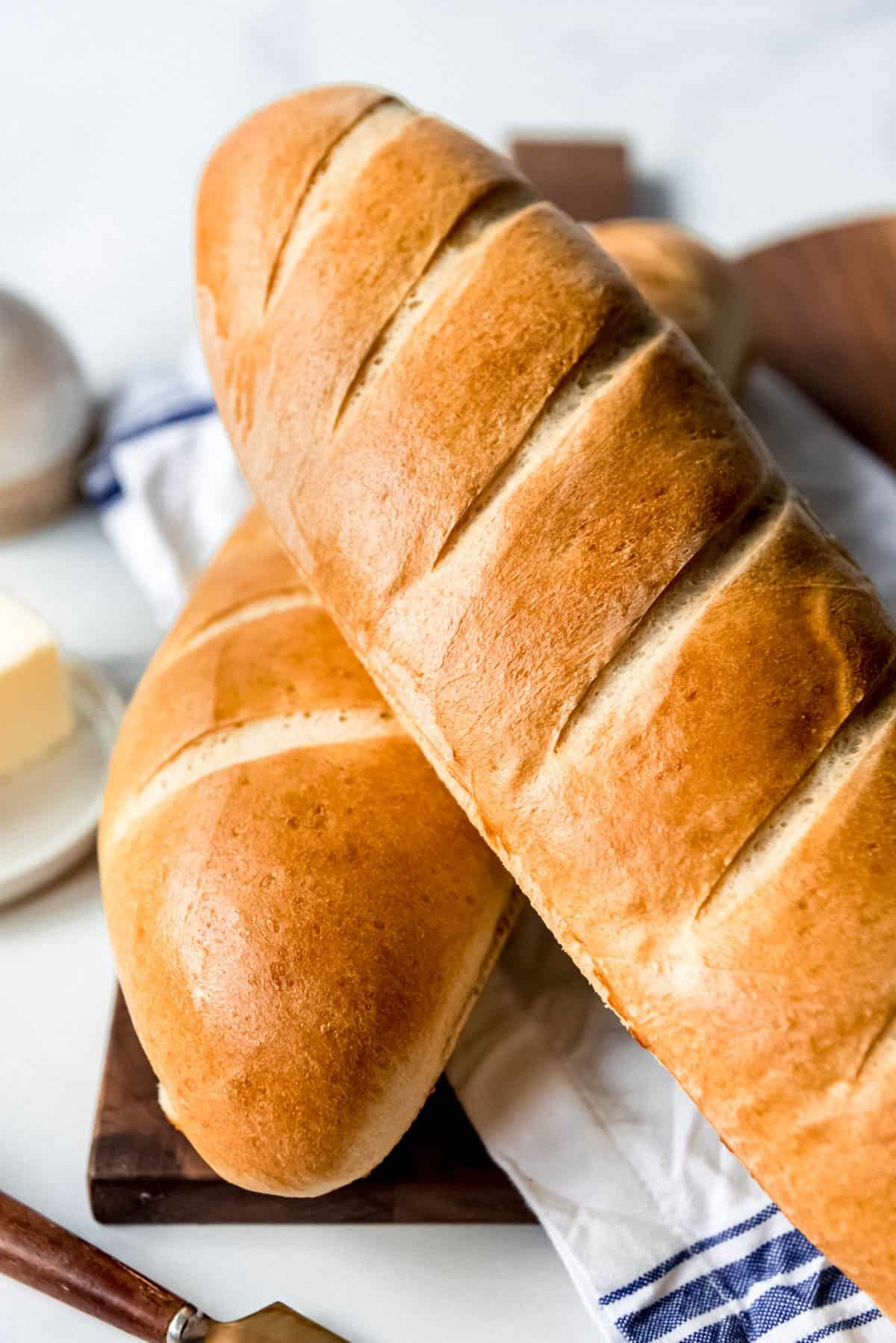
Who doesn’t love a good, chewy loaf of soft french bread? It’s the perfect thing to serve with a bowl of soup, a crisp salad, for making sandwiches, or just for tearing and eating for a snack.
Slice your loaf and smear with garlic butter then toast it under a broiler to make garlic bread or top with pizza sauce and your favorite toppings to make French bread pizza for an easy 20 minute dinner solution. And of course the leftovers make fantastic French toast.
Homemade French bread is actually a simple bread recipe that is easier to make than you might think. Forget the mediocre loaves from the store. Once you try this beginner French bread recipe you will never want to go back to those lackluster loaves again.
Homemade bread is one of the best things to come out of any oven! Some of our other favorite bread recipes are Easy Rosemary Focaccia Bread, Soft Garlic Parmesan Homemade Breadsticks, and Sweet Molasses Brown Bread.
Ingredient Notes
This is a quick overview of some of the important ingredients you’ll need for this French bread recipe. Specific measurements and full recipe instructions are in the printable recipe card at the bottom of the post.
- Flour: I have made this with bread with both all-purpose flour and bread flour and honestly, I don’t have a favorite. Both work great, but the bread flour gives chewier results while all-purpose flour produces slightly lighter and fluffier bread.
- Yeast: I always use active dry yeast, which requires proofing first. But instant yeast can also be used.
- Warm water: I have found that most people who struggle with making bread are using water that is too hot and kills the yeast. It can come from the tap but should just be nice and warm, not hot, to the touch. If you have a digital thermometer, it should be between 105° and 110°F.


How to Make French Bread
If you are using active dry yeast, start out by proofing the yeast in warm water that is between 105° and 110°F with a little sugar for 5-10 minutes until foamy. If the yeast doesn’t get bubbly, chances are it’s either old and expired or your water was too hot and you should start again.
Add the salt, olive oil, and half of the flour, mixing until it starts to combine. I like to do this in my stand mixer with the dough hook attachment. It’s okay if it’s still lumpy.
Add the remaining flour about ½ cup at a time while the mixer is running, until the dough starts to come away from the sides of the bowl. Knead on medium speed for 2-3 minutes until a smooth dough forms. Then turn off the mixer and let the dough rest for 5 minutes. Turn the mixer back on and knead for 2 minutes longer, then transfer to a lightly greased bowl and cover with plastic wrap or a clean cloth. Let the dough rise in a warm spot until doubled in size, about 1 hour.
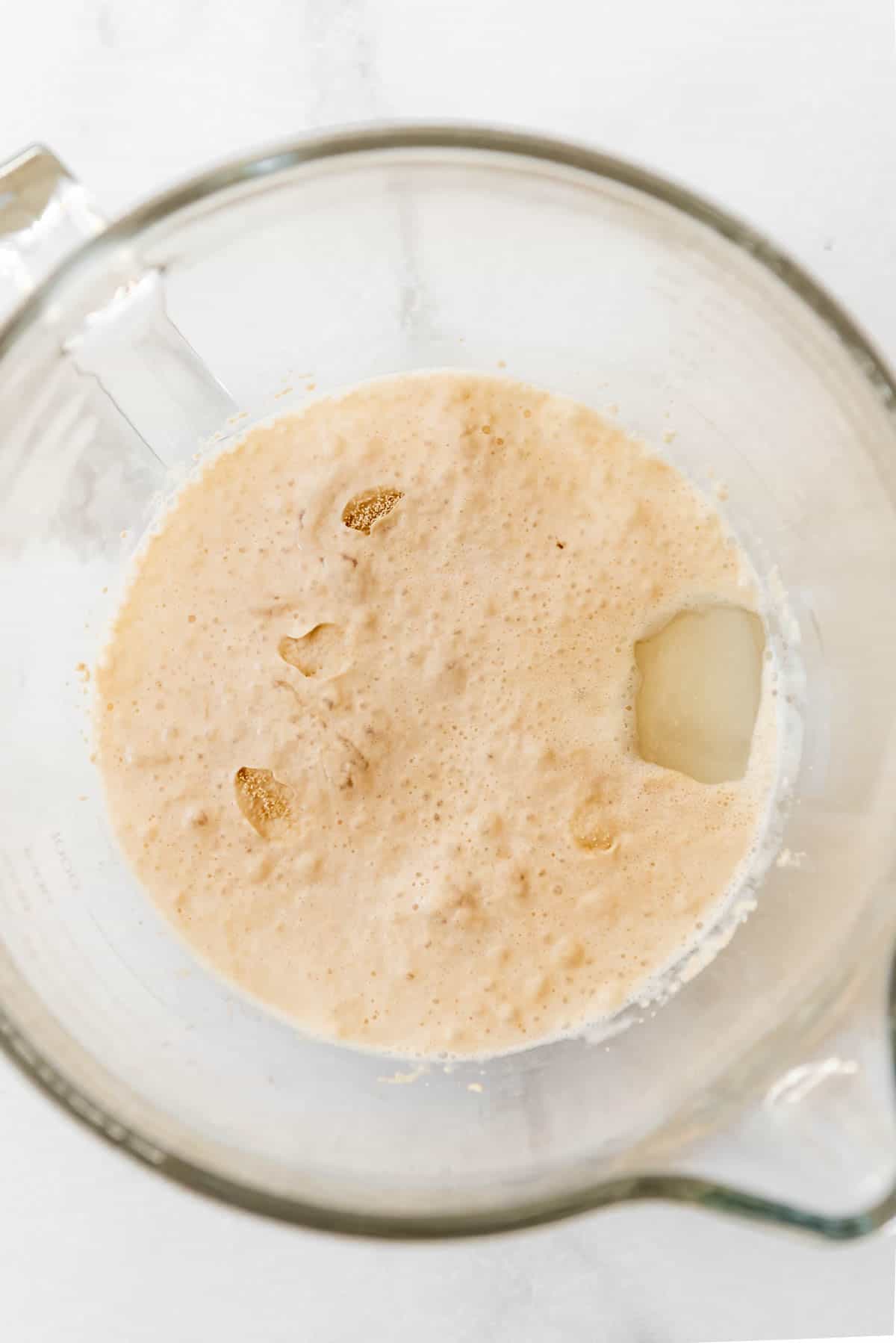

When the dough has risen, punch it down and turn it out onto a clean surface. Cut the dough into two halves and pat one out into a large rectangle that is roughly 9×13-inches. Roll the dough up into a tight cylinder from the long edge, tucking the ends under, and transfer to a baking sheet lined with parchment paper or a perforated French bread pan. Repeat with the other half of the dough to shape a second loaf of bread.
Cover lightly with a piece of plastic wrap or clean towel and let rise another 30 minutes until puffy. Preheat the oven to 375°F while the bread is rising, then brush the loaves with an egg wash and slice gashes into the top of each loaf with a sharp knife just before putting them in the oven.


Throw a handful of ice cubes into the bottom of the oven with the bread and shut the door to create a steamy environment for the bread. Bake for 25-30 minutes until golden brown.
If you want a softer, buttery crust, brush a tablespoon or two of melted salted butter over each loaf while it is still hot out of the oven.
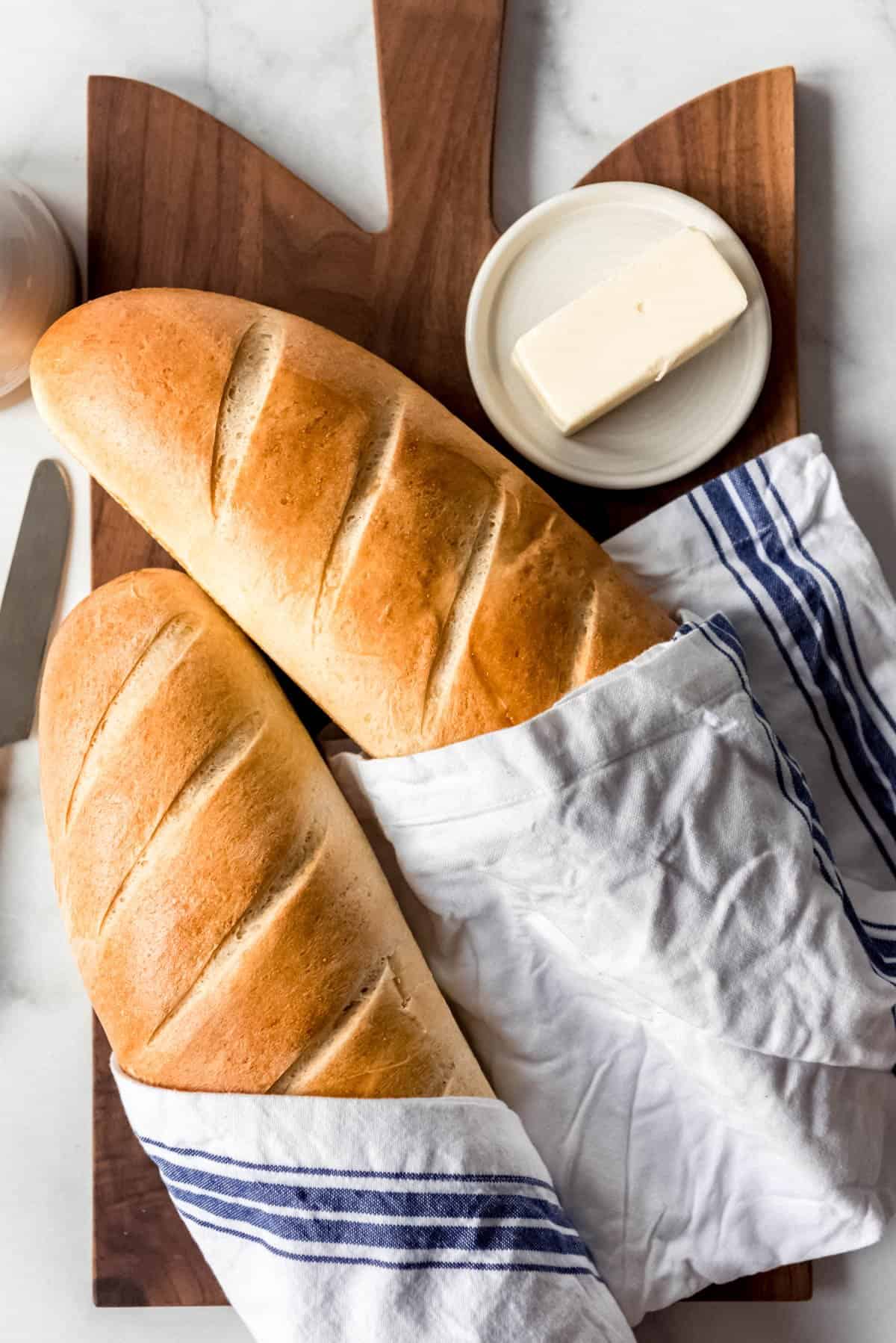
Recipe FAQ’s
Yep! If you have instant yeast, you can skip the steps of proofing the yeast in warm water with sugar, and instead just add everything together with 3 cups of flour and start mixing.
Yes, if you only want 1 loaf of bread, you can definitely halve the ingredients. But keep in mind that French bread freezes well, so as long as you are going to the effort you might as well get a second loaf for sharing or storing for another day.
Storage
This bread is best when enjoyed fresh, but it will keep well for 2-3 days on the counter wrapped in plastic wrap or stored in a Ziploc bag or up to 1 week in the fridge.
Freezing
You can freeze loaves of baked French bread wrapped tightly in two layers of plastic wrap and stored in a freezer-safe Ziploc bag or wrapped in aluminum foil for up to 3 months. Thaw at room temperature before slicing and enjoying.

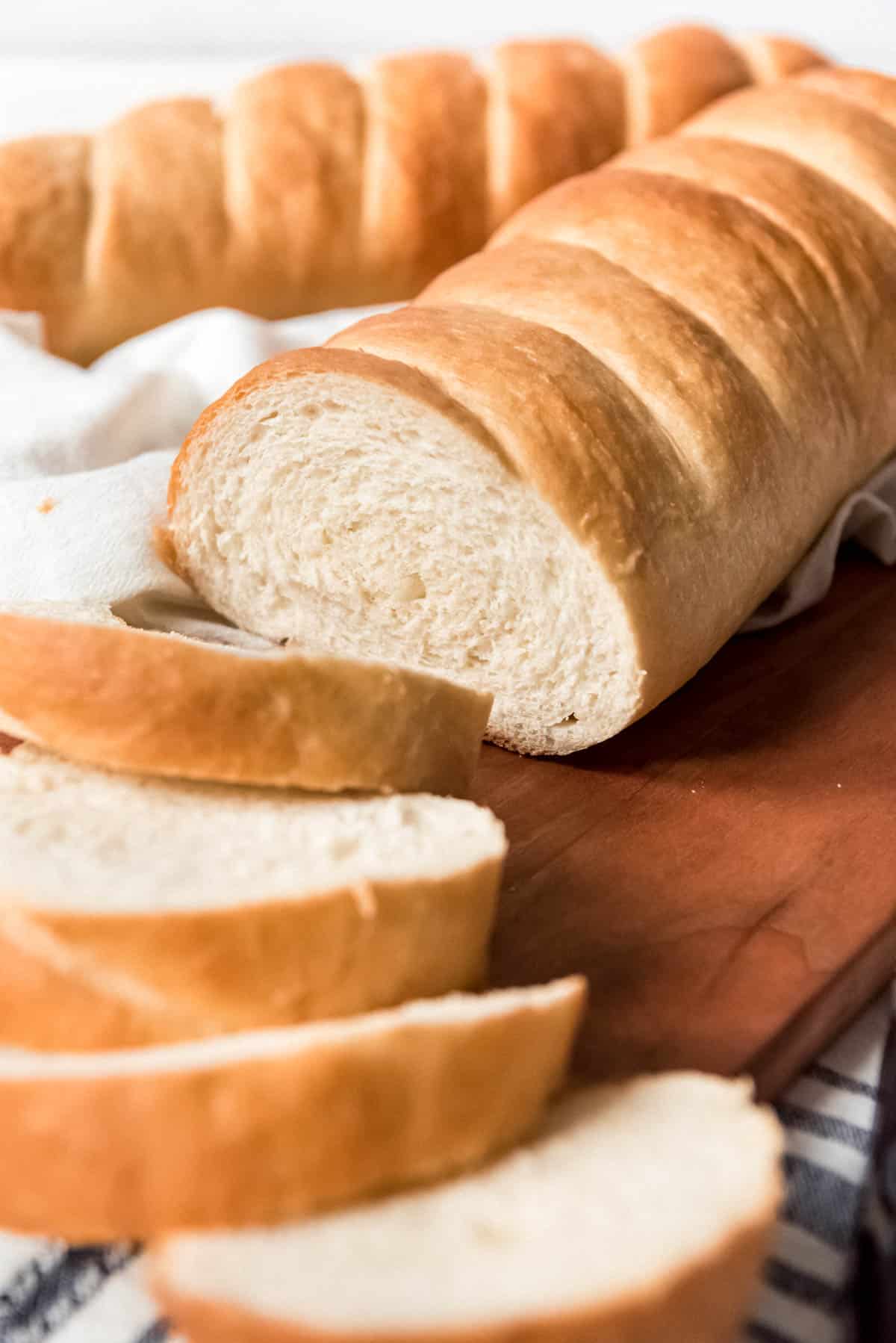
More Homemade Bread Recipes
- Beginner: If you are new to working with yeast, I recommend starting with this easy rosemary foccacia bread (takes less than an hour from start to finish!) or this no-knead artisan bread. Neither recipe requires difficult shaping, and there is little to no effort at kneading the dough.
- Intermediate: If you have worked with yeast before but still aren’t super confident in your abilities, this French bread recipe is a great one to try, as is this Amish white bread. Even homemade naan is a great option for a soft, chewy flatbread.
- Advanced: For those who feel confident in their bread-making abilities, challenge yourself with a dough that requires shaping like this braided homemade challah bread, knotted orange sweet rolls, or cheesy garlic mozzarella swirl rolls
Recipe Tips
- Consider getting a perforated French bread pan. If you find you love making this simple bread recipe, you might want to purchase a French bread pan for even better results.
- Let the dough rest during the mixing process for a minute or two. This allows the gluten to relax before you finish kneading.
- Rise in a warm spot. Yeast breads rise best in warm rooms, which can be tricky if the weather is cold. My favorite spots for letting my bread rise are on top of my stove or by a window if there is sunshine. You can also heat your oven for 10 minutes to 200°F, then turn it off and stick your bread in there to rise with the door cracked, if needed.
- Toss ice cubes into a hot oven to create instant steam. This trick is what helps create that beautiful crust. As soon as you slide your loaves into the hot oven, just throw in a few ice cubes and shut the oven door immediately.
- Use a really sharp knife or bread lame tool to slash gashes in the top of the loaves. This helps the bread cook evenly, releases air bubbles, and makes your bread look pretty. You want your knife or lame tool to be very sharp so it doesn’t deflate the beautifully risen loaves.
- Use an egg wash. If you like French bread with a crispy crust, brush the outside of each loaf with an egg beaten with 1 teaspoon of water before baking.
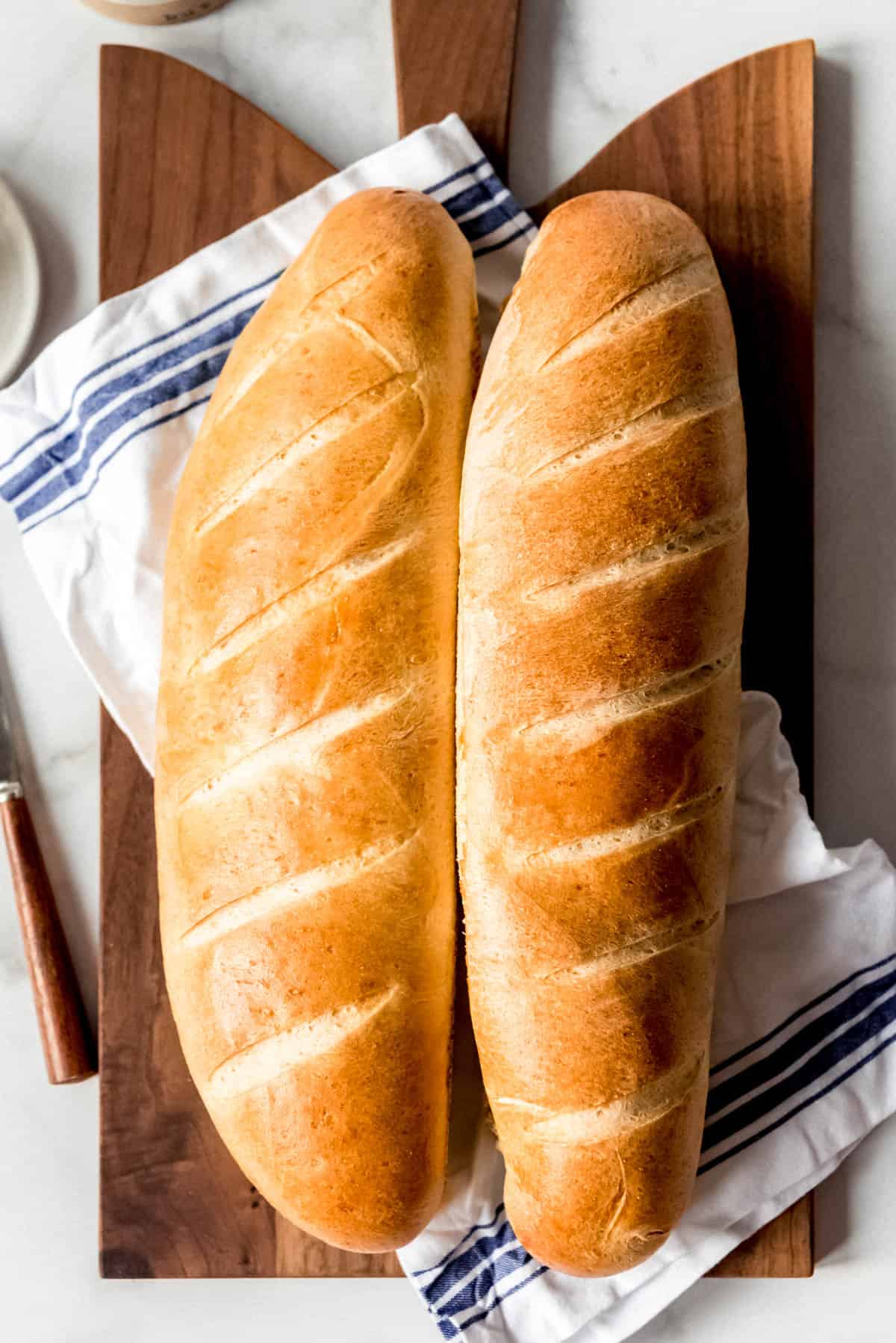
More Bread Recipes
- Sweet Molasses Brown Bread
- Soft Garlic Parmesan Homemade Breadsticks
- Easy Homemade Rye Bread
- Homemade Bread Bowls
More Favorites from House of Nash Eats
Did you make this recipe?
Let me know what you thought with a comment and rating below. You can also take a picture and tag me on Instagram @houseofnasheats or share it on the Pinterest pin so I can see.
Homemade French Bread
Ingredients
- 2 1/4 cups warm water around 110°F
- 1 1/2 Tablespoons granulated sugar
- 1 Tablespoon instant or active dry yeast
- 2 teaspoons table salt
- 2 Tablespoons vegetable oil (olive oil or canola oil also work)
- 5 1/2-6 cups all-purpose or bread flour scooped & leveled (776 to 846g)
- 1 large egg beaten with 1 teaspoon cold water
- Melted salted butter for brushing on top of the baked loaves (optional)
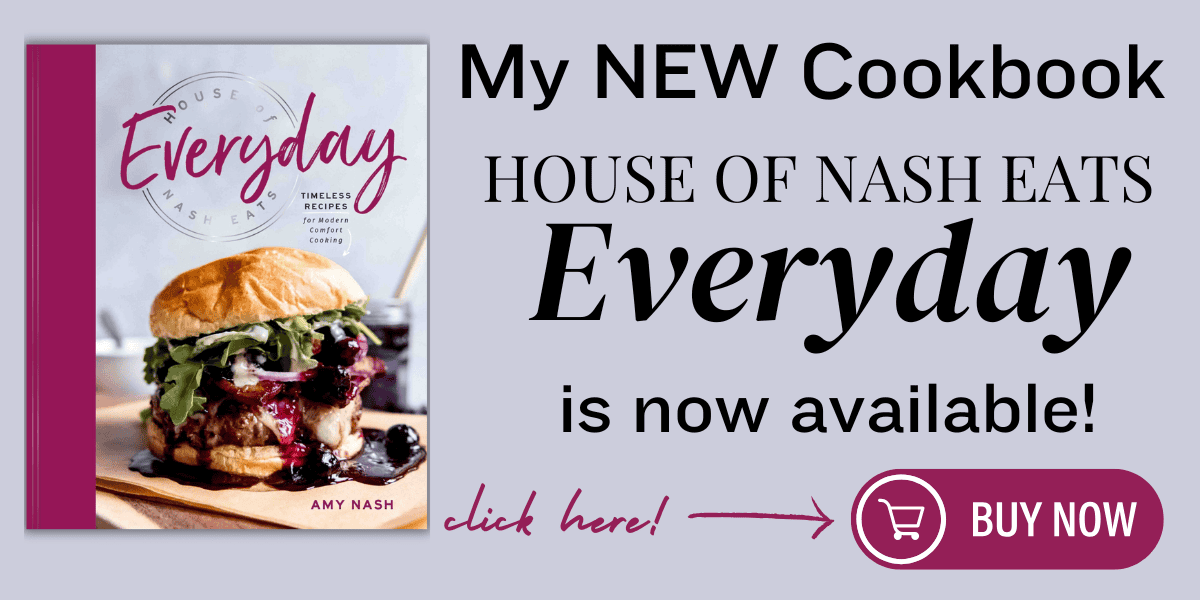
Instructions
- In the bowl of a stand mixer, combine the warm water, sugar, and yeast and let the yeast proof for 5 minutes until foamy (unless using instant yeast, in which case just skip this step and add it with everything in the next step).2 ¼ cups warm water, 1 Tablespoon instant or active dry yeast, 1 ½ Tablespoons granulated sugar
- Add the salt, oil, and 3 cups of the flour to the yeast mixture. Mix for 1-2 minutes, just until it starts to combine. Add in the remaining flour about half a cup at a time while the mixer is running on low speed, just until the dough forms into a ball that starts to come away from the sides of the bowl and is tacky to the touch. Continue to knead the dough for 2-3 minutes until smooth, adding a little more flour if the dough starts to stick to the sides of the bowl again. Let the dough rest for 5 minutes, then knead again for another 1-2 minutes.2 teaspoons table salt, 2 Tablespoons vegetable oil, 5 1/2-6 cups all-purpose or bread flour
- Transfer the dough to a large, lightly greased bowl and cover it with a kitchen towel or a piece of plastic wrap sprayed lightly with cooking spray. Let the dough rise in a warm place until doubled in size, about an hour.
- When the dough has risen, turn it out onto a clean counter that has been lightly sprayed with cooking spray and divide the dough into two equal sections. Working with one half of the dough at a time, pat it into a large rectangle, roughly 9×13-inches.
- Roll the dough up starting from the long edges into a tight cylinder, turning the ends under and pinching the edges together to seal. Place seam side down on a perforated French bread pan or baking sheet lined with parchment paper. Repeat with the remaining dough to form the second loaf.
- Cover the loaves with a kitchen towel or a piece of plastic wrap sprayed lightly with cooking spray and let them rise for another 30 minutes, until nearly doubled again in size.
- Preheat the oven to 375°F while the loaves are rising. Just before putting the loaves in the oven, brush with egg wash, if using, and cut several gashes on an angle about 2-inches apart along the top of each loaf using a very sharp knife or baker's lame.1 large egg
- Transfer the loaves to the oven and toss 3-4 ice cubes onto the bottom of the oven floor and immediately close the oven door.
- Bake for 25-30 minutes until golden brown. Brush loaves with melted butter after removing from the oven for a softer crust, if desired.Melted salted butter
Notes
- Storage: This bread is best when enjoyed fresh, but it will keep well for 2-3 days on the counter wrapped in plastic wrap or stored in a Ziploc bag or up to 1 week in the fridge.
- Freezing: You can freeze loaves of baked French bread wrapped tightly in two layers of plastic wrap and stored in a freezer-safe Ziploc bag or wrapped in aluminum foil for up to 3 months. Thaw at room temperature before slicing and enjoying.
- Salt: You could replace the table salt with 1 Tablespoon of coarse kosher salt.
- Flour: The type of flour used will give slightly different results. All-purpose flour will result in a lighter bread, but bread flour will give a chewier texture. Both are excellent and you can always use half-and-half if you like.
- Rising: Yeast breads rise best in warm rooms, which can be tricky if the weather is cold. My favorite spots for letting my bread rise are on top of my stove or by a window if there is sunshine. You can also heat your oven for 10 minutes to 200°F, then turn it off and stick your bread in there to rise with the door cracked, if needed.
- This recipe is on page 120 of my cookbook, House of Nash Eats Everyday!
Nutrition
This post was originally published in March, 2018. The photos and content were updated in February, 2022.

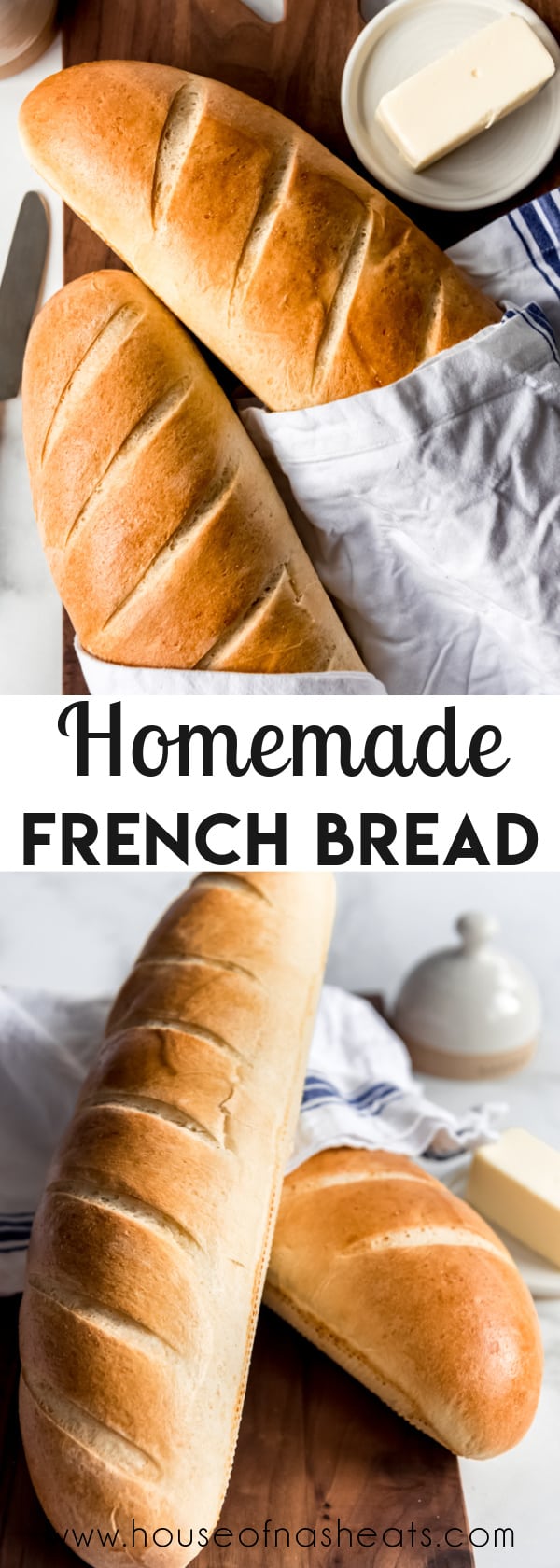
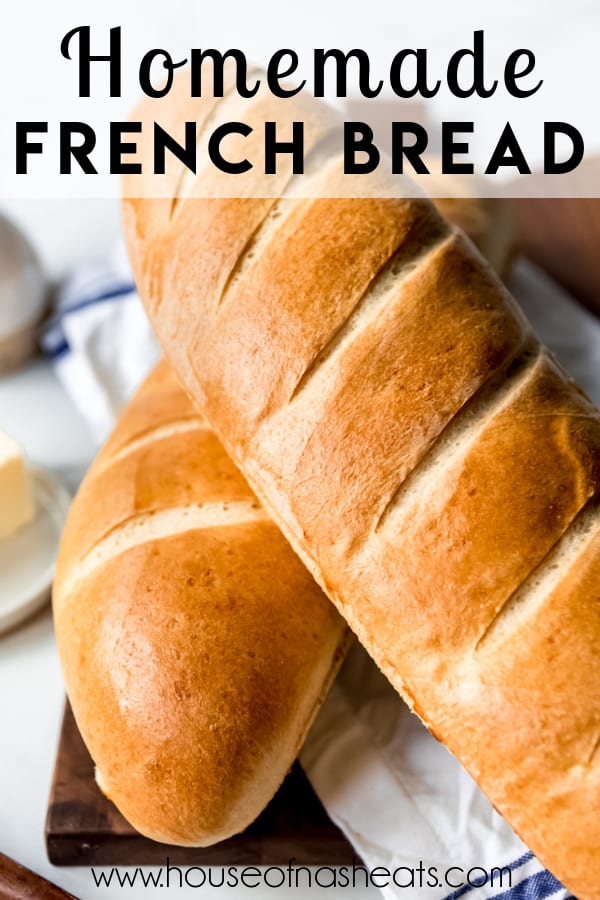
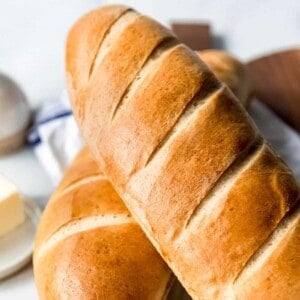





Best French Bread I’ve ever eaten! Wonderful & easy!
Tried and true recipe! I have this recipe bookmarked when I want a delicious loaf or two of bread. Thank you!
So good to hear that!
For this French bread, can I freeze it sliced? Or is it best frozen as a whole loaf?
Honestly you can freeze whole or sliced. If you freeze sliced, you can break it apart and thaw out only the amount you need instead of the whole loaf. But again, either way will freeze well.
No-fail recipe! My family loves this french bread!
I’ve been making French bread for years (probably 40) and this is by far and away the best bread recipe I’ve used. It is better than any bread I’ve ever baked or bought. High praise!!!
Wow you just made my day! Best comment ever, thank you!
Hi! First time bread baker here. It tasted delicious but didn’t get that lovely crackle crust. It was soft. Any suggestions on what i did wrong? I used bread flour and instant yeast.
You didn’t do anything wrong! This recipe does have a softer crust compared to other artisan breads. Creating a nice steamy oven with some ice cubes at the bottom will help form a crust on the bread.
I’m 78 and been making bread since I was 30. This is the best French bread recipe I’ve ever tried by far.
Wow thank you so much! You are an expert bread maker!
I’m wondering if I can add a cinnamon swirl to this?
I don’t see why not. Sounds delicious!
My family meets for dinner every Saturday evening and this bread makes a frequent appearance – on the menu tonight, actually! Such a lovely, easy bread to make. I never change the recipe at all. My family LOVES this bread and so do I.
Wow Thank you! I am so happy to know you love it!
I truly love , and have made so many recipes from your site, and will continue to do so. I have also shared them with my children and grand children at home and abroad.
Wow Mary! That is the nicest thing to say! Nothing makes me happier than knowing you enjoy the recipes and sharing them with others. Thank you!
I am a baker, Great recipe
Add Italian seasoning, garlic powder and parmesan if you like
Thanks Peter! Adding seasoning would be a great addition to the bread.
When my local market kept running out of their in-house French bread on my grocery shopping day, I thought, “how hard could it be?”. Came across this recipe and I’m now bragging to all my friends and family about it. It makes two huge loaves that I slice and freeze for future use. I’m not sure if it’s because I’m in a more humid climate (central Texas), but I have to put in 7 cups of flour before I start to get any semblance of a dough ball, and even then it is still a very, very tacky dough. Still, it comes out just fine each time.
Great, Kristy! Yes, humidity plays a huge part in the ratio of flour for the dough. I am happy you decided to try making the bread! It’s not as scary or hard as people think it is!
I love this recipe! It is consistent and produces really nice french bread.
Thank you so much Nora!